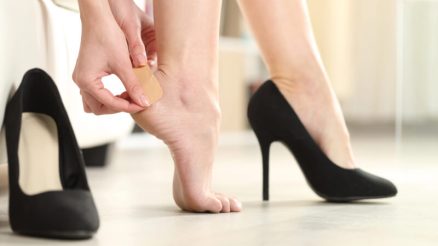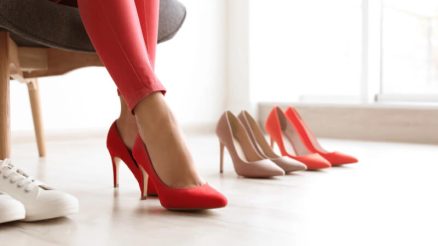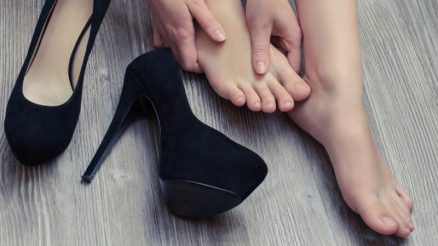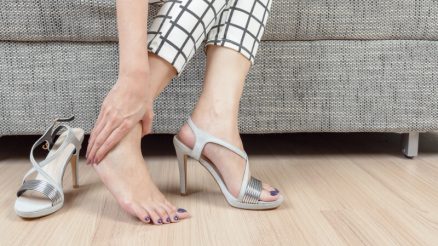There’s nothing quite like the thrill of a brand new pair of heels. The sleek design, the added height, the confidence they exude – it’s all part of the allure. However, that excitement can quickly turn into dread if you’ve ever experienced the agony of breaking in a stiff, unyielding pair. Blisters, pinching, and general discomfort are common woes, but they don’t have to be.
With a little patience and the right techniques, you can transform those unforgiving new heels into comfortable companions, ready for any occasion. Here’s a well-detailed guide on how to break in new heels without pain.
1. The “Wear Around the House” Method (Your First Line of Defense)
This is perhaps the most basic yet effective method. Don’t save your new heels for a grand debut. Instead, wear them around your home for short periods.
- Start Small: Begin with 15-30 minutes at a time.
- Increase Gradually: As they start to feel more comfortable, extend the wear time.
- Pair with Socks: For extra stretching, wear thick socks (or even two pairs of regular socks) with your heels. This gently expands the material, especially in tight areas.
Why it works: This method allows your feet to naturally stretch the shoes without the pressure of having to look good or walk long distances. It also helps you identify problem areas early on.
2. Heat and Stretch (The Blow Dryer Hack)
Heat can make materials like leather and synthetic fabrics more pliable, making them easier to stretch.
- Put on Thick Socks: Wear the thickest socks you can comfortably fit into the heels.
- Apply Heat: Use a blow dryer on a medium setting, directing the warm air at the tightest spots of the shoes (toebox, sides, heel counter). Keep the blow dryer moving to avoid overheating one spot.
- Walk Around: While the shoes are still warm and the material is soft, walk around in them for a few minutes until they cool down.
- Repeat if Necessary: You might need to repeat this process a couple of times.
Caution: Be mindful of the material. This method works best for leather and some synthetics. Avoid using high heat on delicate materials like satin or patent leather, as it can damage them.
3. The Freezer Bag Trick (For Serious Stretching)
This is a clever method for stretching shoes, particularly helpful for the toebox area.
- Fill Ziploc Bags: Fill two sturdy Ziploc bags (or double-bag them for extra security) with water. Don’t overfill – about a quarter to a third full is usually enough, depending on shoe size.
- Place in Shoes: Carefully place one water-filled bag inside the toe box of each shoe. Ensure the bag conforms to the shape of the shoe.
- Freeze Overnight: Place the shoes in the freezer overnight. As the water freezes, it expands, gently stretching the shoe material.
- Thaw and Remove: Once the water is completely frozen, remove the shoes from the freezer and let them thaw for 15-20 minutes before carefully removing the ice bags.
- Try Them On: Try the heels on. They should feel noticeably looser.
Why it works: Water expands uniformly when it freezes, providing even pressure to stretch the shoe.
4. Shoe Stretchers (A Targeted Solution)
For persistent tight spots, a shoe stretcher can be a worthwhile investment. These devices are designed to stretch specific areas of a shoe.
- Types: You can find stretchers for width, length, or even specific bunion stretchers.
- How to Use: Insert the stretcher into the shoe and gradually adjust it to apply pressure to the tight area. Leave it in for 24-48 hours.
- Combine with Spray: For best results, use a shoe stretching spray (often alcohol-based) on the areas you intend to stretch. This helps soften the material.
Pro Tip: If you’re unsure about using a shoe stretcher yourself, a cobbler can often stretch shoes professionally.
5. Moisturize and Condition (For Leather Heels)
Leather needs to be pliable to stretch comfortably.
- Leather Conditioner/Oil: Apply a good quality leather conditioner or oil to the inside and outside of your leather heels. This will soften the leather, making it more flexible.
- Wear Them: After conditioning, wear the shoes around the house for a while to allow your feet to naturally stretch the softened material.
Why it works: Dry leather is stiff and prone to cracking. Conditioning restores its natural oils and elasticity.
6. The “Spoon” or “Deodorant” Trick (For Heel Blisters)
The heel counter is often a notorious spot for blisters.
- Spoon: Rub the back of a large, smooth metal spoon vigorously against the inside of the heel counter. The friction and pressure will help soften the material and make it less abrasive.
- Deodorant: Apply a thin layer of clear stick deodorant to the inside of the heel counter where it rubs against your skin. This creates a friction-reducing barrier.
7. Strategic Padding and Protection
Prevention is key, especially during the breaking-in phase.
- Blister Patches/Tape: Apply blister patches or athletic tape to areas prone to rubbing before you even feel discomfort. Common spots include the back of the heel, sides of the toes, and pinky toes.
- Gel Inserts/Pads: Use ball-of-foot cushions, heel grips, or arch supports. These not only add comfort but can also prevent your foot from sliding, reducing friction.
- Moleskin: This soft, adhesive padding can be cut to size and applied directly to your foot or the shoe’s interior to prevent rubbing.
8. Be Patient and Persistent
Breaking in heels isn’t usually an overnight process. Some shoes will require more time and effort than others.
- Don’t Rush It: Avoid wearing new, untamed heels for a long event or night out.
- Listen to Your Feet: If they start hurting, take them off. Pushing through pain can lead to serious blisters and prolonged discomfort.
- Rotate Shoes: If you have multiple new pairs, rotate them so you’re not always putting pressure on the same spots on your feet.
Breaking in new heels doesn’t have to be a painful ordeal. By using a combination of these methods, you can ensure your beautiful new shoes are as comfortable as they are stylish. Happy walking!








